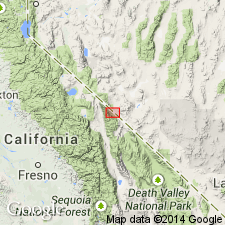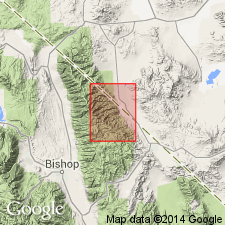
- Usage in publication:
-
- McAfee Adamellite
- Modifications:
-
- Named
- Dominant lithology:
-
- Quartz monzonite
- AAPG geologic province:
-
- Sierra Nevada province
Summary:
[Probably named for McAfee Creek, Mt. Barcroft 15' quad, CA and NV.] Is equivalent to part of Anderson's (1937) Boundary Peak Granite. Underlies area about 61 sq mi and extends beyond north, east, and south borders of quad, Inyo batholith, CA and NV. Is complex of three facies: Aiken, Central, and Garden. Aiken facies (13 sq mi in area) is porphyritic with pale-orange potassic feldspar megacrysts. Central facies (31 sq mi in area) is equigranular with grain size of about 4 mm. Garden facies (also equigranular) averages 1 or 2 mm in grain size. Three facies are shown on geologic sketch map of Mt. Barcroft 15' quad. Contacts with Cabin and Barcroft Granodiorites (both new) and Cottonwood Porphyritic Adamellite (new) show McAfee Adamellite to be younger. Is probably Jurassic or Cretaceous age.
Source: GNU records (USGS DDS-6; Menlo GNULEX).

- Usage in publication:
-
- McAfee Adamellite
- Modifications:
-
- Not used
- Geochronologic dating
- AAPG geologic province:
-
- Sierra Nevada province
Summary:
Central facies and approximately [all of] Aiken facies of McAfee Adamellite of Emerson (1966) is mapped as 'quartz monzonite of McAfee Creek" with K-Ar age determined by E.H. McKee (verbal commun., 1970) of 83.3 Ma (on biotite). Parts of Aiken facies is mapped as "quartz monzonite of Marble Creek" [in area north of McAfee Creek] with K-Ar ages of 74.5 and 70.7 Ma. Garden facies of McAfee Adamellite is mapped as 'quartz monzonite of Indian Garden Creek" [in area south of McAfee Creek] with K-Ar age of 92.7 Ma. Quartz monzonite of McAfee Creek is described as coarse-grained, felsic, quartz-rich biotite quartz monzonite. Fine-grained and porphyritic varieties shown separately on map. Age is Cretaceous.
Source: GNU records (USGS DDS-6; Menlo GNULEX).
For more information, please contact Nancy Stamm, Geologic Names Committee Secretary.
Asterisk (*) indicates published by U.S. Geological Survey authors.
"No current usage" (†) implies that a name has been abandoned or has fallen into disuse. Former usage and, if known, replacement name given in parentheses ( ).
Slash (/) indicates name conflicts with nomenclatural guidelines (CSN, 1933; ACSN, 1961, 1970; NACSN, 1983, 2005, 2021). May be explained within brackets ([ ]).

